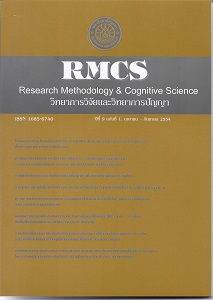การเปรียบเทียบคุณภาพของการปรับเทียบคะแนนตามแนวตั้ง โดยการใช้แบบทดสอบร่วมภายในระหว่างวิธีเชิงเส้นตรง กับวิธีทฤษฎีการตอบสนองข้อสอบแบบสามพารามิเตอร์
Main Article Content
Abstract
การวิจัยนี้มีวัตถุประสงค์เพื่อศึกษาคุณภาพของการปรับเทียบคะแนนตามแนวตั้งโดยใช้แบบทดสอบร่วมภายใน โดยการ เปรียบเทียบความคลาดเคลื่อนและความเพียงพอของการปรับเทียบคะแนนระหว่างวิธีเชิงเส้นตรงกับวิธีทฤษฎีการตอบสนองข้อสอบแบบ สามพารามิเตอร์กลุ่มตัวอย่างเป็นนักเรียนชั้นมัธยมศึกษาปีที่ 1 , 2 และ 3 ในโรงเรียนสังกัดสํานักงานเขตพื้นที่การศึกษากําแพงเพชร เขต 1 ปีการศึกษา 2552 จํานวน 1,080 คน แบ่งเป็น 2 กลุ่ม ได้แก่กลุ่มปรับเทียบคะแนนจํานวน 900 คน และกลุ่มสอบทานผลจํานวน 180 คน เครื่องมือที่ใช้เป็นแบบทดสอบวัดผลสัมฤทธิ์ทางการเรียนวิชาคณิตศาสตร์ เรื่อง สมการ จํานวน 4 ฉบับ ได้แก่ แบบทดสอบสําหรับ กลุ่มปรับเทียบคะแนนตามระดับชั้นจํานวน 3 ฉบับ ๆ ละ 30 ข้อ ซึ่งมีข้อสอบร่วมระหว่างระดับชั้น ฉบับละ 5 ข้อ และแบบทดสอบสําหรับ กลุ่มสอบทานผล 1 ฉบับ จํานวน 80 ข้อ วิเคราะห์ข้อมูลด้วยโปรแกรม BILOG MG
ผลการวิจัยปรากฏว่า
1. ความคลาดเคลื่อนของวิธีทฤษฎีการตอบสนองข้อสอบแบบสามพารามิเตอร์มีค่าน้อยกว่าวิธีเชิงเส้นตรง อย่างมีนัยสําคัญ ทางสถิติที่ระดับ .01
2. ดัชนีความแตกต่าง (C) ของวิธีทฤษฎี การตอบสนองข้อสอบแบบสามพารามิเตอร์ ค่าน้อยกว่าวิธีเชิงเส้นตรง อย่างมีนัยสำคัญ ทางสถิติที่ระดับ .01 แสดงว่า วิธีทฤษฎีการตอบสนองข้อสอบแบบสามพารามิเตอร์มีความเพียงพอของการปรับเทียบคะแนนอยู่ใน ระดับที่น่าพอใจมากกว่าวิธีการปรับเทียบเชิงเส้นตรง
สรุปได้ว่าการปรับเทียบคะแนนตามแนวตั้งโดยใช้แบบทดสอบร่วมภายใน วิธีทฤษฎีการตอบสนองแบบสามพารามิเตอร์ มีคุณภาพดีกว่าวิธีเชิงเส้นตรง
A Comparison of the Relative Quality of the Vertical Equating using Internal Anchor Tests between Linear Equating and Item Response Theory Three – Parameter Model
Jiranart Chavipat, Bantita Insombat and Teerayut Phukao
NakhonSawan Rajabhat University, Thailand
The purpose of this research was to study the quality of vertical equating using internal anchor items by comparing the error and adequacy of equating between linear and IRT three – parameter methods. The sample consisted of 1,080 Grade 7, 8 and 9 students in schools under the Kamphangphet Education Service Area Offi ce, Area I of academic year 2009. This sample was divided into two groups; 900 for the equating group, and 180 for the cross – validation group. The research instruments were four mathematics achievement tests measure the equation, three for the equating group with 30 items with fi ve internal anchor items, and one for the cross – validation group with 80 items. Data analysis with program BILOG MG.
The results were as follow:
1. The error of the IRT three – parameter equating method was found to be less than of the linear equating method at the .01 level of statistical signifi cance.
2. The discrepancy index (C) of the IRT three – parameter equating method was found to be less than of the linear equating method at the .01 level of statistical signifi cance, indicating that the IRT three – parameter equating method results that could be more acceptable than those of the linear equating method.
With regard to vertical equating using internal anchor items, the IRT three – parameter equating method was found to be superior to the linear equating method.

